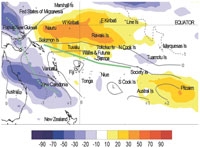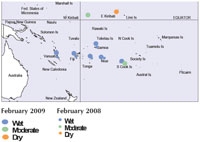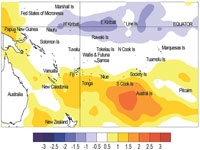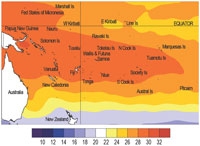Climate developments in February 2009

The South Pacific Convergence Zone (SPCZ) activity was displaced south and west of normal during February, continuing from the trend last month. A region of enhanced rainfall due to intensified convection was observed over northeastern Australia and Papua New Guinea. High rainfall due to an east coast low significantly impacted New South Wales, Australia during the middle of the month, however the most important event in Australia was the severe heat wave that occured from 6–8 Feburary and the associated bush fires in Victoria. Suppressed convection intensified during near the Equator during February, and encompassed the region northeast of the Solomon Islands that included Nauru, Tuvalu, and Tokelau. There was also suppressed convection near the Pitcairn Islands. The regional circulation was characterised by more frequent high pressure across the southern and central portions of the South Pacific; and lower than normal pressures to the northwest of New Zealand and to the northeast of the Marquesas.
There were few high rainfall records during February, only Townsville, Australia reported a new monthly high of 989 mm (339 % of normal). Vanuatu and New Caledonia received well above normal rainfall for the month. In particular, the north Tasman Sea region to the west of New Caledonia and north of New Zealand had well above normal rainfall due to a sub-tropical low pressure system and Tropical Cyclone Innes that occurred in mid–to–late February.
In general, normal or below normal rainfall occurred for the central and northeastern parts of the south Pacific during February. Low rainfall totals (30–60% of normal) persisted for many stations in the Cook Islands, Kiribati, and French Polynesia. Hiva Hoa in the Marquesas Islands received 78 mm of rainfall (50% of normal), while Nanumea, Tuvalu received only 13mm of rainfall (5% of normal). Elsewhere in the eastern half of the southwest Pacific, the stations in the Tuamotu archipelago and the Austral Islands all recorded normal or below normal rainfall, except at Tubuai, which received a record high total of 290 mm (166% of normal).
Northern New Zealand experienced a relatively wet month, with the northern part of the country recording well above normal rainfall (140–230% of normal). The Solomon Islands had a relatively normal month, except at Honiara and Henderson.
| Island Group | Location | Rainfall (mm) | % of average | Comments |
|---|---|---|---|---|
| Australia | Townsville | 989 | 339 | Record high; Highest monthly total in the region |
| New Caledonia | Belep | 402 | 244 | Very high |
| New Caledonia | La Tontouta | 401 | 295 | Very high |
| Solomon Islands | Henderson | 600 | 211 | Very high |
| Kiribati | Kanton | 27 | 26 | Very low |
| Tuvalu | Nanumea | 13 | 5 | Very low |
Soil moisture in February 2009

Estimates of soil moisture shown in the map (right) are based on monthly rainfall for one station in each country. Currently there are not many sites in the water balance model, but it is planned to include more stations in the future.
The information displayed is based on a simple water balance technique to determine soil moisture levels. Addition of moisture to available water already in the soil comes from rainfall, and losses via evapotranspiration. Monthly rainfall and evapotranspiration are used to determine the soil moisture level and its changes. Please note that these soil moisture calculations were made at the end of the month, and for practical purposes, generalisations were made about the available water capacity of the soils at each site.
Nadi (Fiji), Hanan (Niue), Port Vila (Vanuatu), Rarotonga (Southern Cook Islands), and Apia (Samoa) project moist (at or near field capacity) soil moisture conditions. Soils are moderate for the time of year at Kanton (Kiribati).
El Niño/Southern Oscillation (ENSO)


During February, Moderate La Niña conditions continue in the equatorial Pacific Ocean and atmosphere. The SOI remained firmly positive at +1.5 for the month (December – February mean of +1.3). Enhanced easterly trade winds west of the Date Line have weakened during February, but are still stronger than normal.
SST anomalies in February were negative across much of the Equatorial Pacific: NINO3 and NINO4 anomalies were both around –0.7°C for the month (DJF means –0.4°C and –0.6°C, respectively). There is some indication from ocean temperature profile monitoring that the negative SST anomalies may now be easing, though sea surface height anomalies still show a clear La Niña pattern. Equatorial subsurface anomalies continue to show a warm anomaly in the west (+3°C centred near 160°E, 100–200m depth) and a cool anomaly in the east (–3°C near the South American coast, 0–100m depth).
Tropical Pacific convection and precipitation was suppressed near the Date Line, just south of the Equator, and was enhanced across the Tropics at Australian longitudes during February. The TRMM ENSO precipitation index was –0.89 as of 24 February. The MJO is weak and slow-moving over the Indian Ocean, and is expected to remain so into early March.
The set of global climate models assessed by NIWA indicate neutral ENSO conditions will prevail during March – May, and all but one model shows neutral conditions in June - August. The NCEP discussion of 5 February indicates a continuation of La Niña conditions in the coming three month period. The IRI summary of 19 February indicates a 55–60% percent of La Niña conditions persisting through April (40% chance of neutral conditions, 0% for El Niño), reducing to 30–35% for April – June.
Tropical Cyclone Guidance
Tropical Cyclone (TC) Innes, the second to form in the southwest Pacific during the 2008–09 season, developed on 13 February as a tropical depression east of Fiji. On 17 February, after passing over Vanuatu, and tracking to the southwest across New Caledonia, Innes was upgraded to a TC. No significant impacts or loss of life were reported from this system. Subsequent to the extropical exit of TC Innes, the dying tropical depression merged with a low pressure system to the east of Australia. This system then generated significant rainfall in northern New Zealand. Countries west of the Date Line, including Vanuatu, the Solomon Islands, and New Zealand, and New Caledonia still have elevated risk for the remainder of the TC season.
Forecast validation: December 2008 to February 2009
A region of suppressed convection was forecast for the central and eastern Southwest Pacific, and Western Kiribati, Tuvalu, Tokelau, the Northern Cook Islands, and the Society Islands, were expected to receive below normal rainfall. Near–to–below normal rainfall was expected for Samoa, Eastern Kiribati, the Tuamotu archipelago, and the Marquesas Islands. Above normal rainfall was forecast for Papua New Guinea, New Caledonia, Tonga, and Niue. Near or above normal rainfall was forecast for the Austral Islands, Fiji, the Southern Cook Islands, and Pitcairn Island. No clear precipitation guidance was offered for the Solomon Islands or Wallis & Futuna.
The rainfall outlook for the December 2008 – February 2009 period was calculated for 16 island groups (four countries did not report rainfall values). The global station ‘hit’ rate was 70%, 3% higher than average for forecasts made during December and 9% higher than the average for all months combined. Rainfall was overprojected for most of New Caledonia, Tonga, parts of French Polynesia, and underprojected for Western Kiribati and Samoa. Overall, the strike rate for all forecasts combined was 66% for the ICU during 2008.
